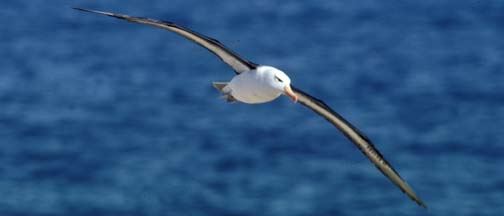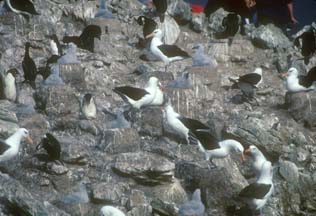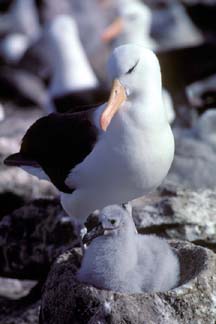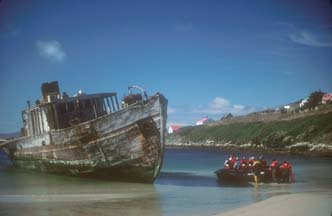
(Click on any image below for a larger version)
Friday, January 19, New Island, Falkland Islands
We arrived at New Island in the Falklands early on Friday morning. The Falkland Islands are low lying, rounded islands that are nearly devoid of trees. They are covered for the most part with grass. The Hanseatic dropped anchor in a sheltered harbor.
 A few white
ranch houses with red and green roofs could be seen on the
island. The wreck of the Protector III, an old minesweeper that
had been used for seal hunting, was grounded near the shore.
A few white
ranch houses with red and green roofs could be seen on the
island. The wreck of the Protector III, an old minesweeper that
had been used for seal hunting, was grounded near the shore.
We bundled up in our parkas and headed down to the storage lockers on the Amundsen deck where we kept our wellies and life jackets. We switched from our shoes into our wellies. Although you tuck your pants inside the wellies, it is important to keep your outer, waterproof pants outside to prevent water from getting into the top of the boots when stepping into deep water.
We were directed down the gangway and a pair of deck hands assisted us into the Zodiac. The water was still and the ride to shore was reasonably smooth. The Zodiac scraped the sand next to the minesweeper wreck. The passengers disembarked from both sides at the front. The method involves sliding forward and then swinging both legs around to the rear, over the pontoon.
Visit the web site of Zodiac of North America.
We waded onto the sandy beach near a stone structure that was identified as Barnard's barn. Barnard had been an early settler in the Falkland Islands. Half of the roof of the barn was lying on the ground next to the barn. It had been blown off during storms in December. The other half of the roof was in the grass about a quarter of a mile away. Barrels were set up on the beach for us to put our life jackets in while we hiked to the rookery.
The expedition followed a primitive road up a gentle incline, across the island to the penguin rookery.
 A single file
of red-jacketed hikers followed each of the two tire ruts.
A single file
of red-jacketed hikers followed each of the two tire ruts.
 A flock of Upland Geese was grazing
in the grass near the roof of Barnard's barn. We spotted a couple
of feral rabbits also.
A flock of Upland Geese was grazing
in the grass near the roof of Barnard's barn. We spotted a couple
of feral rabbits also.
Background information about the Upland Goose.
 The
rookery was located in rocky cliffs above a narrow beach, about a
mile from the landing on the other side of the island. It was
populated by large numbers of Rockhopper Penguins and Blue-eyed
Shags, nesting all mixed together.
The
rookery was located in rocky cliffs above a narrow beach, about a
mile from the landing on the other side of the island. It was
populated by large numbers of Rockhopper Penguins and Blue-eyed
Shags, nesting all mixed together.
Single male penguins advertised their availability with a loud calling display. They raised their beak skywards and flapped their outstretched wings as they sang their penguin song. Each performance lasted the better part of a minute. Often there were a few performers scattered around the rookery singing at the same time.
 Rockhopper Penguins have a crest of yellow feathers sprouting
from the sides of their heads and a set of spiky black feathers
on the top. They have red eyes and an orange beak.
Rockhopper Penguins have a crest of yellow feathers sprouting
from the sides of their heads and a set of spiky black feathers
on the top. They have red eyes and an orange beak.
Background information about the Rockhopper Penguin.
University of Michigan has a page describing Rockhopper Penguins.
 Blue-Eyed Shag
is another name for the King Cormorant. The Shags were black and
white, and were marked very much like the Penguins. They have a
bright blue eye-ring around their eyeball, from whence they
derive their name.
Blue-Eyed Shag
is another name for the King Cormorant. The Shags were black and
white, and were marked very much like the Penguins. They have a
bright blue eye-ring around their eyeball, from whence they
derive their name.
Background information about the King Cormorant.
The penguins had to negotiate a rocky, penguin highway to get down to the water a hundred feet below the rookery. After feeding in the open ocean, the adult penguins climbed back up the rocky path, hopping up a few inches at a time with a belly full of fish to feed their chicks.
 Penguin chicks cluster together in groups called creches while
they wait for the adults to bring them food.
Penguin chicks cluster together in groups called creches while
they wait for the adults to bring them food.
 When an adult Rockhopper Penguin reached its chicks it identified
them by calling to them and listening for their distinctive
little penguin voices. The chicks would nuzzle the beak of the
adult, prompting it to regurgitate the fish that it had caught.
The chick would stick its head right into the open mouth of the
adult to get its meal. Once the chick had gotten its fill, the
adult would swallow back down what the chick hadn't taken.
When an adult Rockhopper Penguin reached its chicks it identified
them by calling to them and listening for their distinctive
little penguin voices. The chicks would nuzzle the beak of the
adult, prompting it to regurgitate the fish that it had caught.
The chick would stick its head right into the open mouth of the
adult to get its meal. Once the chick had gotten its fill, the
adult would swallow back down what the chick hadn't taken.
 This Rockhopper Penguin has been fitted with a
radio transmitter to track its movements.
This Rockhopper Penguin has been fitted with a
radio transmitter to track its movements.
 Black-browed Albatrosses circled overhead on the rising air
currents above the cliffs. Their nests were concentrated on one
side of the rookery.
Black-browed Albatrosses circled overhead on the rising air
currents above the cliffs. Their nests were concentrated on one
side of the rookery.
Link to the Falklands Conservancy pages about the Black Browed Albatross.
 Each Albatross had built a nest out of a mound of guano that was
slightly larger in diameter than its downy, gray albatross chick.
Rockhopper Penguins and Blue-Eyed Shags wandered freely
throughout the Albatross rookery.
Each Albatross had built a nest out of a mound of guano that was
slightly larger in diameter than its downy, gray albatross chick.
Rockhopper Penguins and Blue-Eyed Shags wandered freely
throughout the Albatross rookery.
 The Albatross chicks have oversized beaks and black stripes
running around the sides of their face, so it looks like they are
wearing beak masks.
The Albatross chicks have oversized beaks and black stripes
running around the sides of their face, so it looks like they are
wearing beak masks.
 There were
several brown Falklands Skuas with white patches on their wings
circling above the rookery.
There were
several brown Falklands Skuas with white patches on their wings
circling above the rookery.
Background information about the Falklands Skua.
 We hiked back across the island to
Barnard's Barn. The residents of New Island set up a table with
souvenirs next to Barnards Barn. On the left side of the barn you
can see art prints of whales that had been drawn by Kim Chater, a
woman who lives on the island.
We hiked back across the island to
Barnard's Barn. The residents of New Island set up a table with
souvenirs next to Barnards Barn. On the left side of the barn you
can see art prints of whales that had been drawn by Kim Chater, a
woman who lives on the island.
 We boarded the Zodiac next to the minesweeper
wreck and returned to the Hanseatic.
We boarded the Zodiac next to the minesweeper
wreck and returned to the Hanseatic.
 The Hanseatic at anchor off New Island.
The Hanseatic at anchor off New Island.
 Table of
Contents
Table of
Contents You can buy a 2020 Calendar featuring my photographs of Antarctic Landscapes.
A dozen photos of Antarctic Landscapes. Locations include:
Cape Wild and Cape Lookout on Elephant Island,
Paulet Island,
the Weddell Sea,
Neko Harbor in Andvord Bay on the Antarctic Peninsula, and
Deception Island.
 Put a copy of the Antarctic Landscapes 2020 Calendar in your Lulu.com shopping cart for $14.95.
Put a copy of the Antarctic Landscapes 2020 Calendar in your Lulu.com shopping cart for $14.95.
You can buy a 2020 Calendar featuring my photographs of seals taken in Antarctica.
A dozen photos of seals in Antarctica. Seals pictured include:
Antarctic Fur
Weddel
Crabeater
Southern Elephant.
Locations include:
Cape Lookout on Elephant Island
Deception island
Livingstone Island
Antarctic Sound.
 Put a copy of the Antarctic Seals 2020 Calendar in your Lulu.com shopping cart for $14.95.
Put a copy of the Antarctic Seals 2020 Calendar in your Lulu.com shopping cart for $14.95.
You can buy a 2020 Calendar featuring my photographs of birds taken in the Falkland Islands and the South Shetland Islands in Antarctica.
A dozen photos of birds taken in the Falkland Islands South Shetland Islands in Antarctica. Birds pictured include:
Southern Giant Petrel
Black Browed Albatross
Falklands Skua
Blue-Eyed Shag (King Cormorant)
Black Crowned Night Heron
Patagonia Duck
Pied Oystercatcher
Snowy Sheathbill
Cape Petrel
Kelp Gull.
 Put a copy of the Birds of the South Atlantic and Antarctica 2020 Calendar in your Lulu.com shopping cart for $14.95.
Put a copy of the Birds of the South Atlantic and Antarctica 2020 Calendar in your Lulu.com shopping cart for $14.95.
You can buy a 2020 Calendar featuring my photographs of penguins taken in Antarctica and the Falkland Islands.
A dozen pictures of penguins taken in Antarctica and the Falkland Islands. Penguin species pictured include:
Gentoo
Adele
Chinstrap
Rockhopper
Macaroni
Magellanic
King.
Locations where the photographs were taken in the Falkland Islands include:
New Island
Carcass Island
Volunteer Point.
Antarctic locations include:
Paulet Island
Cape Lookout on Elephant Island.
 Put a copy of the Penguins 2020 Calendar in your Lulu.com shopping cart for $14.95.
Put a copy of the Penguins 2020 Calendar in your Lulu.com shopping cart for $14.95.
 Send
a message to Brian.
Send
a message to Brian.